by Dave Senf
January 2015
Note: All data except for Minnesota's PMI have been seasonally adjusted. See the feature article in the Minnesota Employment Review, May 2010, for more information on the Minnesota Index.
The Minnesota Index ended the year on a sour note, remaining unchanged from November's reading. After racing along with 0.3 percent monthly increases from April to August, Minnesota's index lost momentum during the last four months of 2014. The flat reading in December implies that Minnesota's economy failed to expand for the first time since January 2010. Minnesota's unemployment rate continued to drop in December, but wage and salary employment declined, and waning average weekly manufacturing hours kept the index from advancing. The U.S. index continued to race ahead in December increasing 0.3 percent for the 11th straight month. Minnesota's economic growth as measured by the Minnesota index has trailed U.S. economic growth over the last four months.
Minnesota's index was up only 2.6 percent from a year ago which is the smallest over-the-year gain since December 2010. The U.S. index was up 3.5 percent from a year ago. Minnesota's over the year increase hasn't fallen this far below the U.S. increase since March 2007. Minnesota's economic recovery from the Great Recession was ahead of the nation's recovery until this month. As of December, Minnesota's economy is up 14.8 percent from September 2009, while the U.S. economy is 15.1 percent larger. Past slowdowns in Minnesota's index have been revised away as data are revised, so it is too soon to draw any firm conclusions about the strength of Minnesota's economy especially since other indicators are giving more favorable signals about the state's economy.
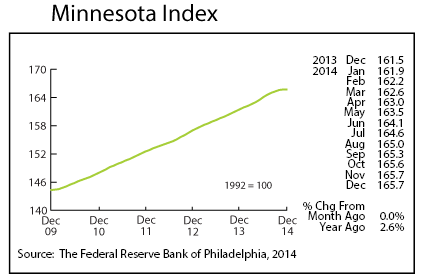
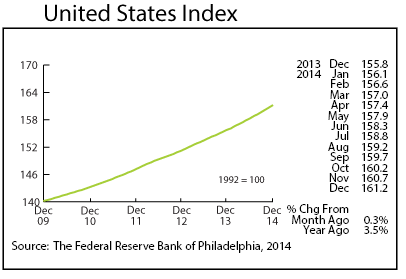
Adjusted Wage and Salary Employment dropped sharply in December, declining by 5,200 jobs. It was the worst job report since April when 5,300 jobs were lost. The private sector cut 1,000 jobs while the public sector cut 4,200 jobs. State government payrolls were reduced by 1,600 while local government payrolls shrank by 2,500. Only three private super sectors added jobs with Trade, Transportation, and Utilities added the majority of positions. Job cuts in the private sector were highest in Educational and Health Services, Manufacturing, Financial Activities, and Leisure and Hospitality.
Minnesota's unadjusted job growth over the year plunged to 1.2 percent, the lowest since September 2012. The U.S. rate jumped to 2.2 percent which was the highest rate since September 2000. Minnesota's over-the-year job growth has slipped way behind the national level over the last four months.
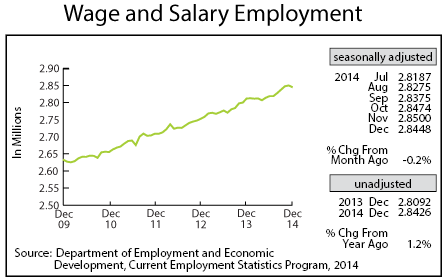
The tail-off in Minnesota's job growth is surprising given climbing adjusted online Help-Wanted Ads. Help-wanted advertising, which many consider a proxy for labor demand, increased for the third month in a row, advancing to another record high of 129, 600. December's level was 10.2 percent higher than a year ago compared to the 4.7 percent 12-month national increase.
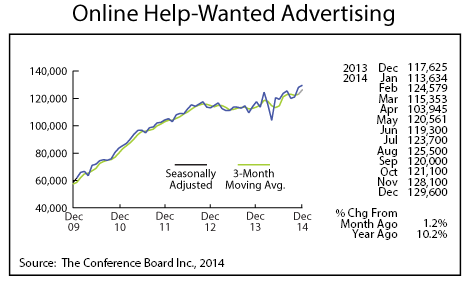
Minnesota's Purchasing Managers' Index (PMI) rose for the first time in four months in December, recording the largest jump since February to 61.4. Minnesota's index topped both the U.S. index (55.1) and Mid-American Index (54.4) again in December. Minnesota's below U.S. job growth in December is inconsistent with the state's higher purchasing managers' index.
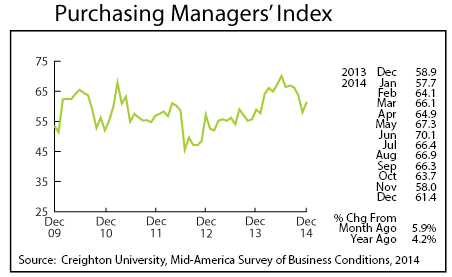
The plunge in adjusted Manufacturing Hours in December to 41.2 is, however, consistent with slowing job growth. Minnesota's factory workweek hasn't been this low since April 2013. The shrinking factory workweek pushed Manufacturing Earnings to their lowest level in two years. Seasonally unadjusted but inflation adjusted average weekly earnings were 4.2 percent below a year ago.
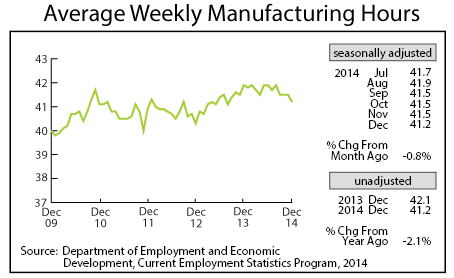
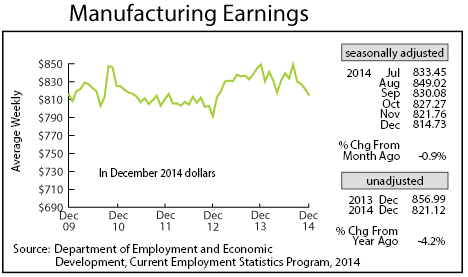
The Minnesota Leading Index plunged again in December, recording its seventh straight drop. The index fell to zero, the lowest level since July 2009. The zero reading implies that Minnesota's economy will experience no growth over the next six months. This is obviously a huge red flag that will hopefully prove false with data revisions.
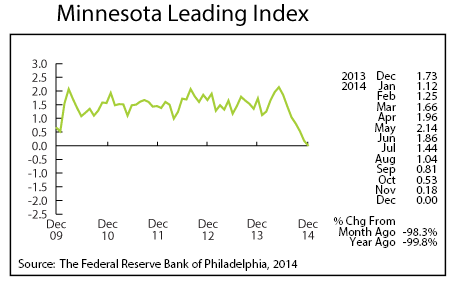
Adjusted Residential Building Permits bounced back sharply in December, soaring 62.7 percent to 1,356. The pace of home building activity in Minnesota last year once again fell below expectations. Permit numbers increased 80 percent in 2012 after bottoming out in 2011 but the annual gain since then has been disappointing with an 8 percent increase in 2013 and only a 2.0 percent gain in 2014. Nationally residential building permits were up 4.8 percent in 2014.
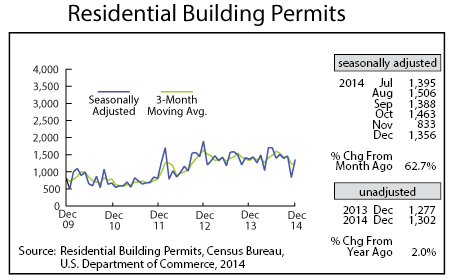
Adjusted Initial Claims for Unemployment Benefits (UB) tumbled in December after spiking in November. December's drop off was inconsistent with the more ominous indicators. Total initial claims for 2014 were down 14.3 percent from 2013, the fifth straight year of declining initial claims.
